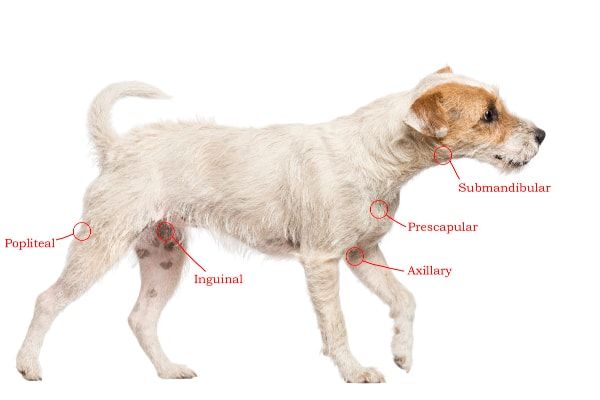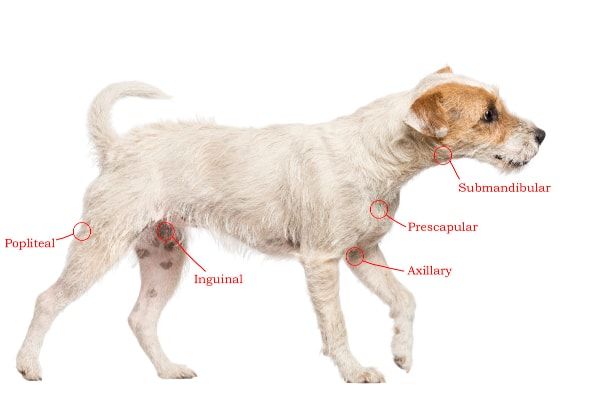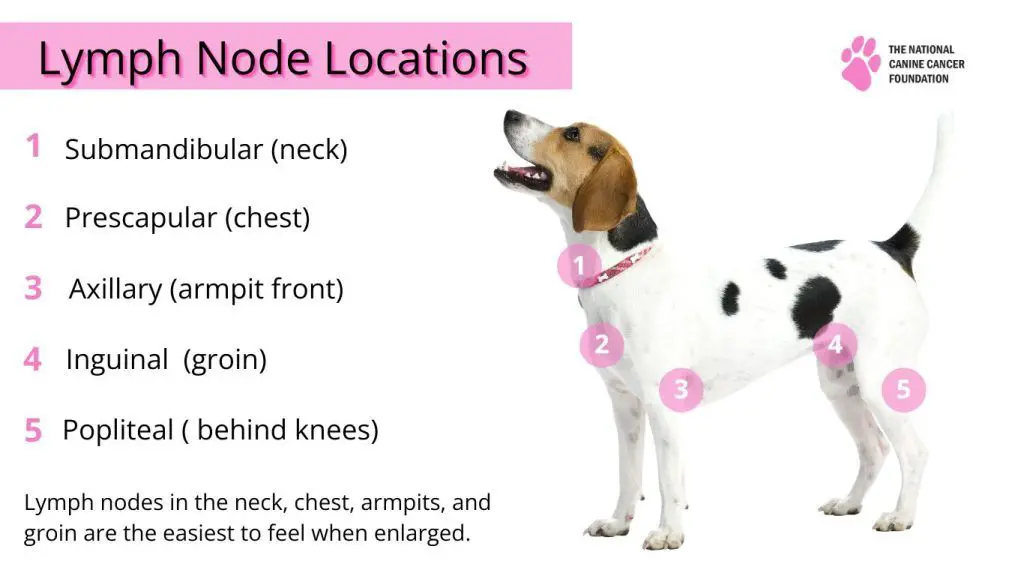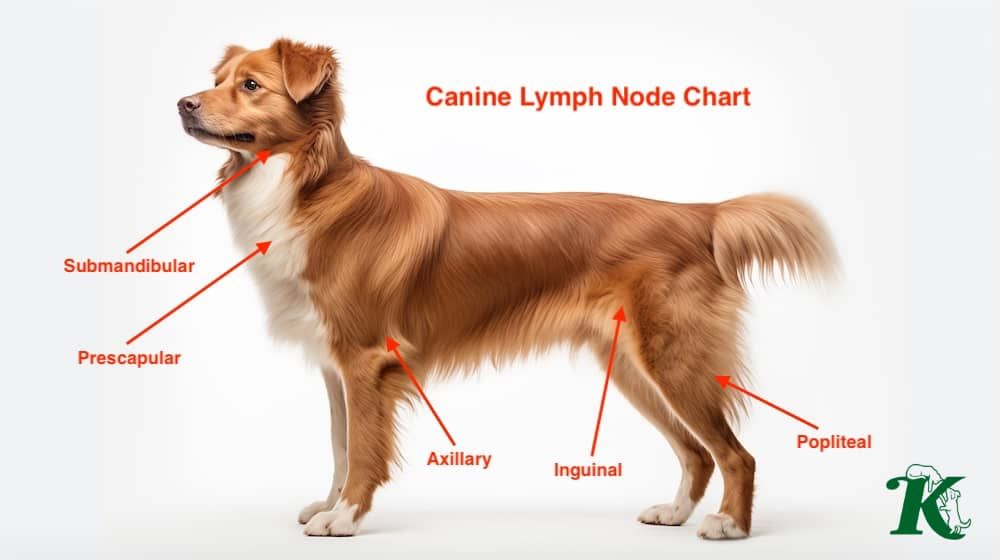What are Popliteal Lymph Nodes?
The popliteal lymph nodes are located behind the knee joint in dogs (Popliteal Lymph Nodes – USask OpenPress). They are part of the lymphatic system, which helps filter fluids and fight infection. The popliteal lymph nodes drain lymph fluid from the rear legs and filter out toxins, bacteria, and other unwanted substances. There is typically one popliteal lymph node on each leg in dogs. They are oval or bean-shaped and range in size. The popliteal lymph nodes filter lymph fluid as it travels through the lymphatic system before returning it to the circulatory system. When functioning properly, these lymph nodes play an important role in removing toxins and helping the dog’s immune system.
Causes of Swollen Popliteal Lymph Nodes
The most common causes of swollen popliteal lymph nodes in dogs include:
Injury or trauma – Direct injury to the legs, knees, or hips can cause inflammation and swelling of the nearby lymph nodes. This is the body’s normal response to injury as it tries to fight off any potential infection.
Infection – Bacterial, viral, fungal or parasitic infections can all spread to the popliteal lymph nodes and cause them to swell as they become reactive. Common infections include skin infections like cellulitis, abscesses, wound infections, and more systemic infections like kennel cough.

Cancer – Lymphoma and other cancers like soft tissue sarcomas can first appear as swollen popliteal lymph nodes. Cancer causes chronic inflammation and swelling as the nodes react to the cancer cells. Enlarged nodes are often the first clinical sign noticed in dogs with lymphoma (source).
Other less common causes include autoimmune disorders, allergic reactions, chronic inflammation, and congestive heart failure. It’s important to get an accurate diagnosis from your veterinarian to determine the underlying cause and guide treatment.
Symptoms of Swollen Popliteal Lymph Nodes
The most common symptoms of swollen popliteal lymph nodes in dogs include:
Pain: Dogs may exhibit signs of pain and discomfort behind the knee where the lymph nodes are located. They may cry out when the area is touched or avoid bearing weight on the affected leg.
Swelling: A visibly enlarged, round, firm lump may be seen behind the knee. The lump may range from pea-sized to over an inch in diameter as the lymph node swells.1

Limbing: Dogs may limp or favor the hind leg on the side with the swollen node. They may avoid bending the knee or have difficulty moving the leg normally.
Difficulty Moving Leg: Stiffness, reluctance to move, or inability to fully extend the leg may occur with swollen popliteal lymph nodes. Dogs may also tire more quickly or have trouble going up stairs.
In addition to the localized swelling and pain behind the knee, dogs may exhibit other general signs like lethargy, loss of appetite, and fever depending on the underlying cause.
Diagnosing the Cause
To diagnose the cause of swollen popliteal lymph nodes in dogs, veterinarians will start with a complete medical history and physical exam. They will palpate the swollen lymph nodes and check for pain, inflammation, and any abnormalities. The size, texture, mobility, and warmth of the lymph nodes provide clues about the cause.
The veterinarian may recommend imaging tests such as x-rays, ultrasound, CT scan or MRI to get a closer look at the swollen lymph nodes and surrounding structures. These imaging tests can help identify underlying infections, cancers, or other issues that may be causing the swollen lymph nodes.
A sample of cells from the lymph node may be taken via fine needle aspiration or biopsy. Examining these lymph node cells under a microscope can reveal infections or cancerous cells. Cultures can also be taken to identify any infectious organisms. These diagnostic tests help veterinarians pinpoint the root cause of the swollen popliteal lymph nodes.
With a combination of a thorough physical exam, patient history, imaging tests, and lymph node cytology or biopsy, veterinarians can accurately diagnose the cause of swollen popliteal lymph nodes in dogs.
Treatment Options
There are several treatment options available for swollen popliteal lymph nodes in dogs:
Antibiotics may be prescribed if there is an infection causing the swelling. Common antibiotics used include amoxicillin, doxycycline, and cephalexin. Antibiotics help kill off the bacteria causing the infection and reduce the swelling.
Anti-inflammatory medication like meloxicam or carprofen can help reduce swelling and pain associated with the enlarged lymph nodes. They work by inhibiting prostaglandins that drive inflammation.

In severe cases where there is a tumor or cancer present, the enlarged lymph node may need to be surgically removed. This is done to prevent the cancer from metastasizing and spreading to other areas of the body.
For lymphomas and some other cancers, radiation therapy may be used to shrink the tumors and reduce swelling. Radiation is targeted directly at the cancerous lymph nodes.
The vet will determine the appropriate course of treatment based on identifying the underlying cause and severity of the swollen nodes. Often a combination of medication and antibiotics is used. In extreme cases, surgical removal or radiation may be warranted.
Recovery and Prognosis
The recovery and prognosis for swollen popliteal lymph nodes in dogs depends on the underlying cause. In cases of infection, the swelling should go down once the infection is successfully treated with antibiotics or other medications. Some rest may be required while the body fights the infection. For dogs diagnosed with arthritis, swollen lymph nodes may persist but can be managed long-term with anti-inflammatory medications. In more serious cases like cancer, swollen lymph nodes may not fully resolve even with treatment. However, cancer treatments like chemotherapy can help prolong life and allow dogs to live comfortably for months or even years.
Regardless of the cause, owners should follow up regularly with the veterinarian to monitor the swollen lymph nodes. If they do not start to decrease in size within 1-2 weeks of beginning treatment, further diagnostic tests may be required. With prompt veterinary care and attentive at-home care, most dogs recover fully from swollen popliteal lymph nodes. However, owners should watch closely for any signs of recurrence and contact the vet immediately if the swelling returns.
Preventing Swollen Popliteal Lymph Nodes
There are some steps dog owners can take to help prevent swollen popliteal lymph nodes from developing:
Avoid injuries – Take precautions to avoid injuring your dog’s legs and paws which can lead to infections. Keep floors free of sharp objects, use booties when walking on hot pavement or rocky areas, and keep nails trimmed to avoid scratches.
Manage infections – Be diligent about treating any wounds, hot spots, dental infections, ear infections, etc. that could spread bacteria to the lymph nodes. Follow veterinary recommendations for medication and care.
Routine vet exams – Annual exams allow vets to check for signs of infection and inspect the popliteal lymph nodes directly. Bring up any concerns about swelling or discomfort in the hind legs.
Keep vaccinations current – Vaccines help prevent infections from viruses like parvovirus, distemper, and rabies that could otherwise affect the lymph nodes.[1]
Use flea/tick control – Parasites can transmit diseases that cause lymph node inflammation. Use monthly preventatives as prescribed by your veterinarian.
Feed a nutritious diet – Proper nutrition supports immune system function and wound healing. Follow your vet’s dietary guidelines.
When to See a Veterinarian
It’s important to have your vet examine your dog if you notice any swelling in the popliteal lymph nodes that lasts more than 24 hours. Swollen lymph nodes can be a sign of a serious underlying condition, so it’s best to have it checked out. Some other signs that warrant a veterinary visit include:
- Swelling that is rapidly increasing in size
- Your dog seems to be in pain or discomfort in the hind leg area
- Your dog is limping and holding the hind leg up
- There are external signs of trauma, injury, or infection around the swollen node
- Your dog seems lethargic, feverish, or generally unwell
- The swelling doesn’t go down after a few days of home treatment and rest
Your vet will be able to do tests like a fine needle aspirate or biopsy to determine the cause of the swollen lymph nodes. Getting a prompt diagnosis is important, as some causes like an infection will require medication, while others like cancer may need surgery and follow-up treatment. Don’t wait too long to get your dog checked out if the popliteal lymph nodes remain swollen. Call your vet whenever you notice anything abnormal or concerning.
Sources:
https://www.petmd.com/dog/conditions/cancer/c_multi_lymphadenopathy
https://www.kingsdale.com/causes-of-swollen-lymph-nodes-in-dogs
Caring for Your Dog at Home
If your dog has swollen popliteal lymph nodes, there are some things you can do at home to help care for them:
Rest is very important, so limit your dog’s activity and exercise while their nodes are swollen. Take short, gentle walks instead of strenuous playtime. This will help reduce inflammation and discomfort.
Apply cold compresses to the affected area several times a day for 10-15 minutes at a time. This can help reduce swelling and relieve pain. Wrap an ice pack or frozen bag of vegetables in a towel before applying to your dog’s leg behind the knee.

Provide supportive care by giving your dog soft places to rest, like beds and blankets. Make sure they have easy access to food, water, and trips outside. Monitor them for signs of pain or changes in swelling.
While home care can help, it’s still important to follow up with your veterinarian, especially if swelling persists or your dog seems uncomfortable. Your vet may prescribe medications or other treatments to properly manage the underlying cause of the swollen nodes.
With rest and supportive care at home, most dogs recover well from transient popliteal lymph node swelling. But working closely with your veterinarian ensures the best outcome for your pup.
Long-Term Outlook
The long-term outlook for a dog with swollen popliteal lymph nodes depends greatly on the underlying cause. Some causes like an infection may resolve on their own or with treatment, while swollen lymph nodes due to cancer may indicate a more serious long-term prognosis.
It’s important to follow up with your veterinarian after the initial diagnosis so they can monitor your dog’s progress. Your vet will be able to give you the most accurate prognosis for your individual dog’s condition based on the cause, lab results, response to treatment, and other factors.
In general, dogs who receive prompt veterinary care and follow their prescribed treatment plan have better prognoses. Close follow up care with your vet is key, as they can change or adapt treatments as needed if your dog’s condition changes.
While swollen popliteal lymph nodes themselves are not necessarily life-threatening, the underlying disease process causing them may be serious if left untreated. With supportive care from your vet and proper treatment, many dogs go on to live happy and healthy lives after resolving the issue that caused their swollen lymph nodes.